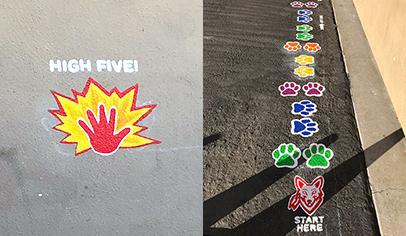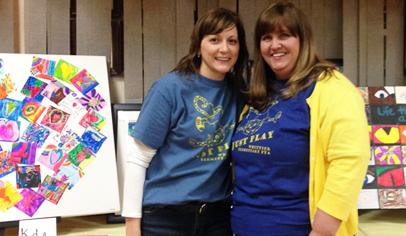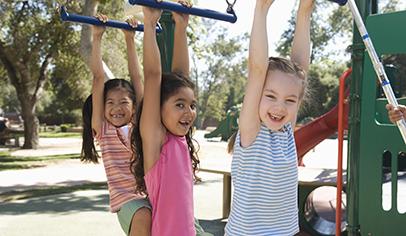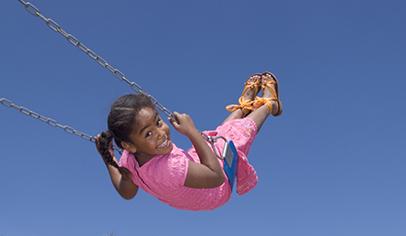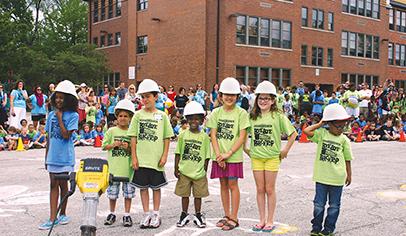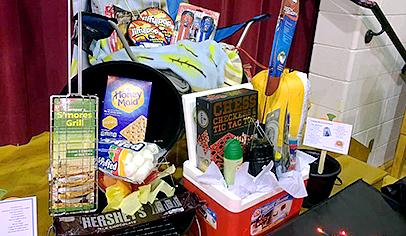At. T.S. Hancock Elementary in Houston, home to a deaf education cooperative and a preschool program for children with disabilities, staff members work hard to break down barriers for students in and out of the classroom. But despite their best efforts, some students had to watch from the sidelines during recess.
The more than 20 deaf students with cochlear implants had to choose between hearing and playing on the plastic slides, where the same static that makes children’s hairs stand on end could damage fragile processors. Many of the school’s handicapped population could not access the large play structure, where most children played.
When PTO leaders started talking about renovating the school’s nearly 20-year-old playground, they made a key decision — the new playground would be accessible to all the school’s students, including those using wheelchairs and cochlear implants.
“We decided if we were going to do this project, we wouldn’t go half way,” PTO President Debbie English says. “Every slide would be available to every child. We wanted to make it a feel-good place for every kid in this building, and not just the 80 to 90 percent who can hear.”
In addition to raising $100,000 to design and build a new playground, the PTO worked with school staff, parents, and a playground designer to provide plenty of play options for all students. To make the playground easier to use for those with cochlear implants, the PTO opted to install metal slides, even though it increased the cost of the project and required special permission from the school district. The new playground includes activities on the ground level, such as tic-tac-toe and talking tubes, for those with limited mobility. In addition, the PTO purchased two handicap-accessible swings for use by two students who use wheelchairs.
The PTO launched the project in the fall of 2002, expecting fundraising to take three years. With the help of the community, the PTO completed the project in 18 months, just in time for the school’s 30th birthday celebration.
Play for All
The overhaul of Hancock’s playground was long overdue. Since the metal play structures were installed almost 20 years ago, the school’s enrollment has doubled to about 880. As playground equipment deteriorated, the school district removed pieces without replacing them. As a result, children crowded onto the largest play structure, which was designed to accommodate less than 50.
The new playground, completed in April, has a large play structure for students in kindergarten through fifth grade. The preschool play structure is identical, but built on a smaller scale. Students can choose from five slides and 4-foot and 8-foot freestanding rock-climbing walls. On the ground is a conversation pit, a theater system with a puppet window, and a hidden area with dinosaur tracks where children pretend to be archaeologists on a dig.
Many of the school’s 45 deaf students are mainstreamed in the classroom, so hearing students learn basic sign language skills. Plastic safety rails on the play structure are printed with the American Sign Language alphabet, reinforcing these language skills.
Students in Hancock’s preschool program for children with disabilities can access the smaller playground structure. “Those with severe handicaps go to the smaller one, and teachers and paraprofessionals hold their hands and they’re able to climb onto the equipment,” says Principal Kathy Dickson.
The redesigned space includes areas that can be used for classes. A cluster of five picnic tables can be used as an outdoor classroom. A side of one table does not have seating, so students in wheelchairs can join classmates. A preschool table sits lower to the ground. In addition, the playground includes a paved jogging trail, which can be used for physical education classes.
Before the renovation, the playground often sat empty after school hours, even though it is in the center of a residential neighborhood. Now the playground is a community gathering place. Neighbors walk on the jogging trail, and children ride their bicycles to the school, parking them in new bike racks before hitting the playground.
Making It Happen
Not only did the PTO face the challenge of raising $100,000 and designing an entirely new playground, the group needed to do it without taking money away from its other activities at the school. They started with $7,500 in seed money left over from a cookie dough sale, and formed an eight-member committee that pledged to stick with the project for the long haul.
Fundraising efforts started small, with students raising about $4,000 by selling poinsettias before Christmas and chocolate rabbits in the spring.
Dickson spoke with students about the part they could play, and encouraged them to do chores at home to raise money. Students held lunchtime change races that raised over $2,000. English took so many pennies to the bank that the PTO went over its limit and had to get a special pickup from the Federal Reserve. Bank employees didn’t complain. They contributed $100 to the project.
Families made private donations, some with matching contributions from employers. Teachers participated by paying a combined $750 for the privilege of wearing blue jeans to school.
The PTO publicized the fundraising campaign in the school newsletter, subdivision newsletters, and the local newspaper, according to Volunteer Coordinator Mingo Williamson. This brought donations from parents of former students, and community members gave money for trash cans and park benches.
Students tracked the fundraising progress on a giant thermometer in the cafeteria. Each time they learned how much money they had raised, students asked Dickson, “OK, so the playground will change tomorrow?”
Fundraising efforts kicked into high gear with help from the community. A parent suggested approaching the area utility districts. The Prestonwood Forest Utility District offered to match contributions up to $50,000. Another area utility provider, the Emerald Forest Utility District, pledged $24,000 to the project.
Working with the utility districts meant meeting their requirements, primarily that the project not kill any trees or contribute to flooding. An urban forester, a father at the school, donated his services to design the tree plan. Williamson’s husband, a civil engineer, designed the jogging trail and made recommendations for placement of the playground structures.
As the PTO neared its $100,000 goal, it approached the Willowbrook Rotary Club, which donated the final $6,000.
With the funding for the project secured, the PTO turned its attention to playground design. The playground committee visited area schools that had recently completed playground projects and surveyed teachers and parents about what children liked best. The PTO worked with a school district-approved vendor to design a play area all children could enjoy.
In addition to keeping existing pine trees, which provided shady places to play on hot days and could keep temperatures from rising too high on the metal slides, the urban forester recommended planting new ones. The PTO bought 1,000 pine seedlings and 250 hardwood seedlings from a state program for $150. On Arbor Day, 25 members of the Willowbrook Rotary Club planted trees at the school, and the school sent a pine seedling home with each student.
Students became increasingly eager to see the new playground in the spring as construction neared, but work was delayed when building materials did not arrive on schedule. When bulldozers arrived to tear down the old equipment, English raced outside the school to stop them.
When construction finally began in March, students played on the blacktop and on swing sets, but kept a close eye on the workers’ progress. “When they were placing poles and putting them in cement, the kids would actually clap!” Dickson says. “They were so involved because they had a piece of it. They own that playground, too.”
Workers installed the jogging trail during spring break, and the final touches were completed on April 1. On April 2, students raced outside at recess to explore the new playground.
The new playground has made a big difference for deaf students with cochlear implants, Dickson says. Before, if these students wanted to play on the slide, they had to disengage their implants and navigate the playground without hearing. “Now they have access to hearing and access to their friends,” she says.
Some Ways to Create Access
More than 5 million children in the United States have a disability that makes it difficult for them to enjoy traditional playgrounds, according to the National Center for Boundless Playgrounds in Bloomfield, Conn.
Accessibility means more than just complying with the Americans with Disabilities Act, which focuses on access for those who use wheelchairs or walkers. Playground design should allow children with different needs to engage in normal play behavior, says Dianne Noth, Boundless Playgrounds’ senior director of operations.
“What’s going on on that playground is helping them get life skills,” Noth says. “If they don’t get those experiences, they’re going to be at a disadvantage, whether they have a disability or not.”
Before starting work on a playground project, evaluate the needs of the school population. Explore ways to meet those needs and to provide challenging play opportunities.
Visually impaired children benefit from sensory-rich play activities, such as play panels with different textures, sound implements, and pathways with slight changes in grade or texture. Children with partial sight may be able to see differences in color. Using different colors at each elevation can help them get around the playground independently.
Children with autism or Asperger’s syndrome often play autonomously, and need quiet areas where they can play on their own. Children with attention deficit disorder may also benefit from isolated play areas.
Those with Down syndrome benefit from activities that help improve their balance, such as balancing bars.
As a general rule, include as many play activities on the ground level as there are on higher levels of play structures. Instead of sand boxes, use sand tables or water tables so that children in wheelchairs can enjoy them.
When evaluating wheelchair access, make sure ramps go where children want to play. Paths and doorways should be wide enough to accommodate wheelchairs, and children using wheelchairs should be able to cross ground cover to reach at least some of the playground equipment. Gravel, wood chips, and sand prevent wheelchair access.
Transfer decks allow children to leave their wheelchairs and reach higher levels of playground equipment, but keep in mind that some children may feel vulnerable leaving their wheelchair behind.
Making playgrounds more accessible benefits children and adults. Children without handicaps enjoy the new additions to the playground designed for handicapped children. And increasing access allows parents and grandparents with impaired mobility to play with children or more closely supervise play, Noth says.
For more information about Boundless Playgrounds, visit www.boundlessplaygrounds.org.












